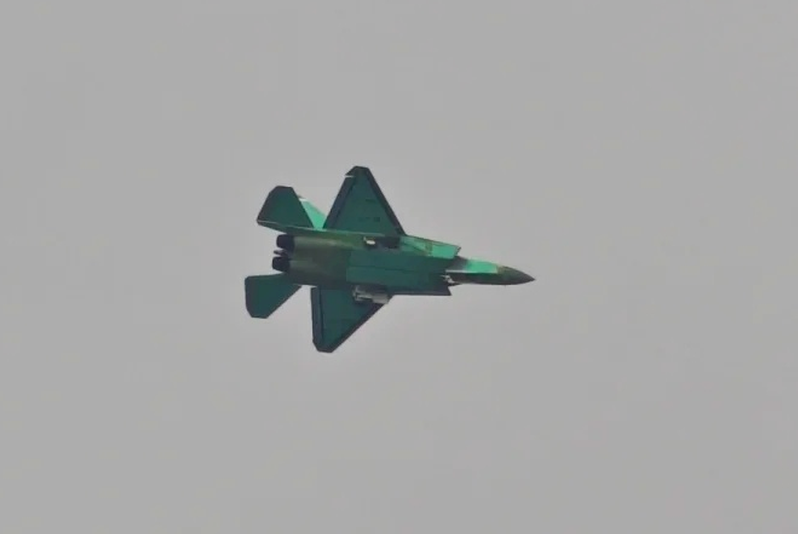Game-Changer for the Indo-Pacific: J-35 Officially Joins China’s Carrier Air Wing
This historic milestone marks the first time Beijing’s naval forces are fielding true fifth-generation combat aircraft, significantly elevating the PLAN's ability to conduct advanced stealth operations from both land-based installations and future aircraft carriers.
In a landmark development set to alter the balance of airpower in the Indo-Pacific, China has officially inducted its first serial production J-35 fifth-generation stealth fighters into operational service with the People’s Liberation Army Navy (PLAN).
This historic milestone marks the first time Beijing’s naval forces are fielding true fifth-generation combat aircraft, significantly elevating the PLAN’s ability to conduct advanced stealth operations from both land-based installations and future aircraft carriers.
The official induction was confirmed through a striking air-to-air photograph—originally circulated via the Chinese social media platform Weibo—depicting two J-35 jets in tight formation, marked with PLAN insignia and bearing construction numbers 0011 and 0012.
The image, believed to be a sanctioned release, is widely interpreted as showcasing low-rate initial production (LRIP) units now entering frontline naval service.
While some observers have speculated about the potential use of prototype airframes repainted with LRIP-conforming identifiers for information warfare purposes, the clear markings and naval emblems on the vertical stabilizers strongly suggest that the J-35 has indeed passed into an operational phase with the PLAN.
The aircraft’s prominent shark-themed tail art, similar to motifs seen on the PLAN’s carrier-based J-15s, further reinforces its assignment to naval aviation units.
The induction of the J-35 into both the PLAN and the People’s Liberation Army Air Force (PLAAF)—within just two weeks of each other—demonstrates the impressive pace of Chinese aerospace industrialization and underlines the fighter’s growing strategic value across service branches.

For the PLAN in particular, the arrival of the J-35 is nothing short of transformational.
Until now, China’s naval aviation relied heavily on fourth-generation platforms, most notably the Shenyang J-15 and its improved J-15B variant, which, despite incremental upgrades, lack the low observable features that define modern air dominance.
With the J-35’s stealthy airframe, internal weapons bays, and advanced electronic warfare suite, the Chinese Navy now possesses the capability to conduct carrier-based operations in contested environments while remaining virtually invisible to enemy radar systems.
This technological leap places China among the elite group of nations—currently only the United States—that can project stealth-enabled air power from the sea.
Designed by Shenyang Aircraft Corporation, the J-35 serves as a lighter, more maneuverable counterpart to the Chengdu J-20 and fills the performance gap between the heavyweight twin-engine J-20 and the lighter single-engine F-35B/C operated by the U.S. Navy and Marine Corps.
The J-35’s configuration—twin engines, stealth shaping, and carrier-optimized architecture—makes it especially suitable for operations from China’s next-generation flat-top carriers, such as the Type 003 “Fujian,” which features advanced CATOBAR (Catapult Assisted Take-Off But Arrested Recovery) launch systems.
Unlike the ski-jump decks of the older Type 001 and Type 002 carriers, the CATOBAR system is specifically designed to accommodate heavier and stealthier aircraft like the J-35, offering greater operational range and payload capacity.

Once these jets are fully carrier-qualified, China will effectively field a sea-based fifth-generation combat capability—something no nation outside the United States currently possesses.
The strategic consequences are profound.
The deployment of stealth aircraft at sea allows the PLAN to execute precision strike, reconnaissance, and air superiority missions deep within adversary-controlled maritime zones, all while evading detection from traditional radar and infrared tracking systems.
This is particularly critical in flashpoint regions such as the South China Sea, Taiwan Strait, and East China Sea—areas where the PLA seeks to maintain a dominant position amidst escalating tensions with the United States and its regional allies.
The J-35’s introduction also aligns with China’s overarching “system-of-systems” warfare doctrine, integrating data links, satellite support, airborne early warning, and precision-guided munitions into a seamless kill chain—enhancing lethality and survivability.
The fighter is expected to operate in tandem with the heavier J-15B in a high-low mix, mirroring doctrinal concepts once used by the U.S. Navy with the F-14 Tomcat and F/A-18 Hornet.
This layered force composition allows for mission flexibility while ensuring that high-end stealth assets like the J-35 are deployed in scenarios where their low observability and advanced sensors offer a decisive edge.



